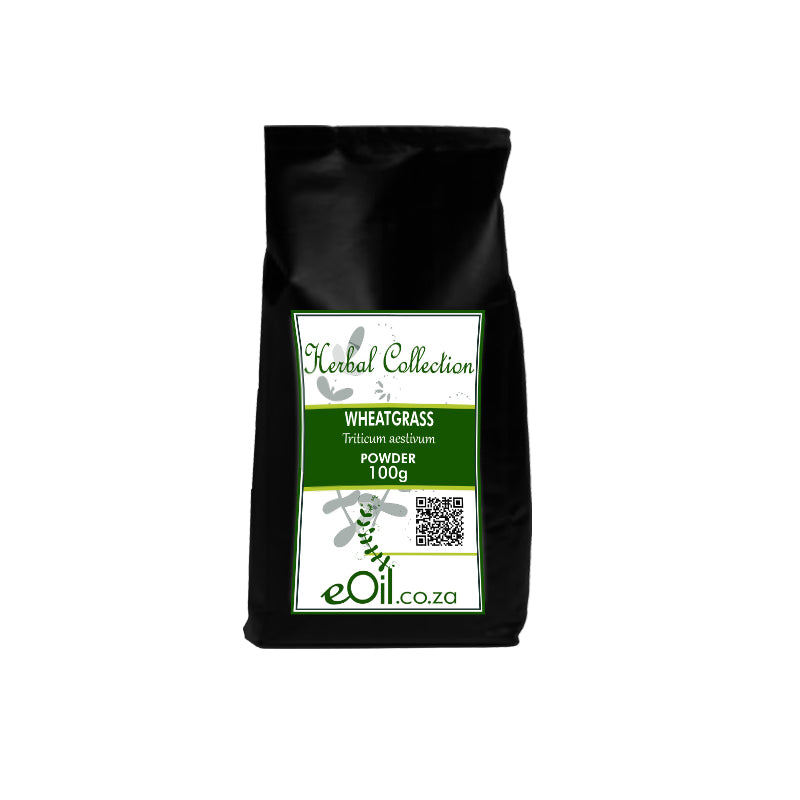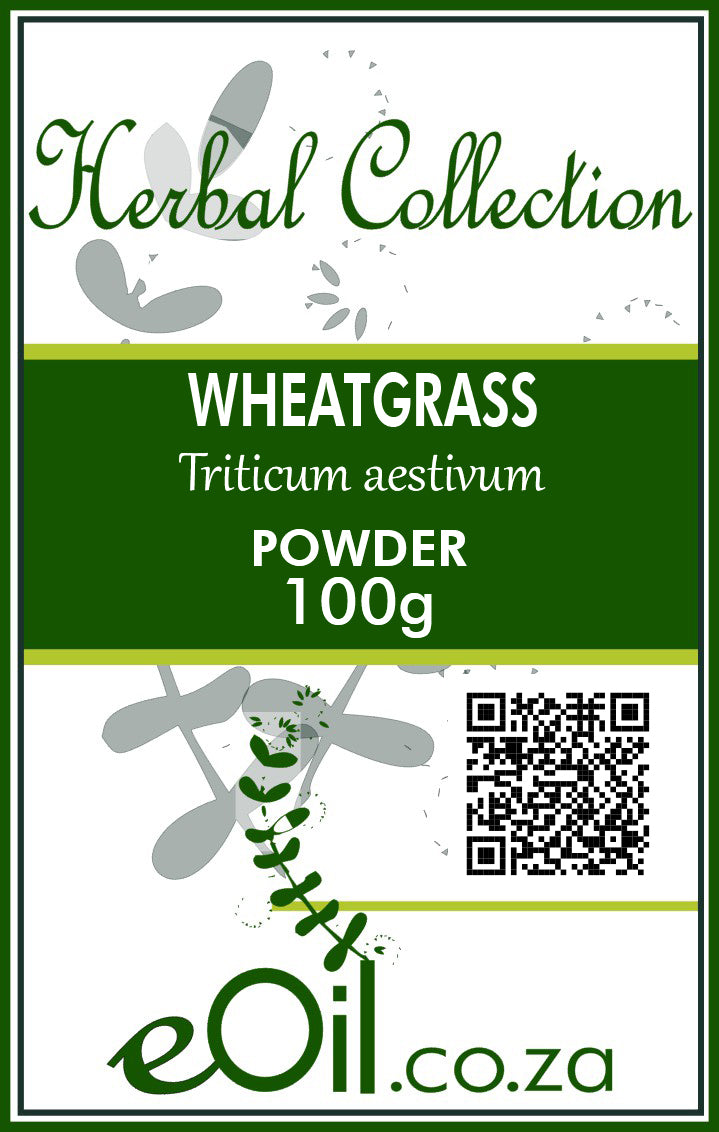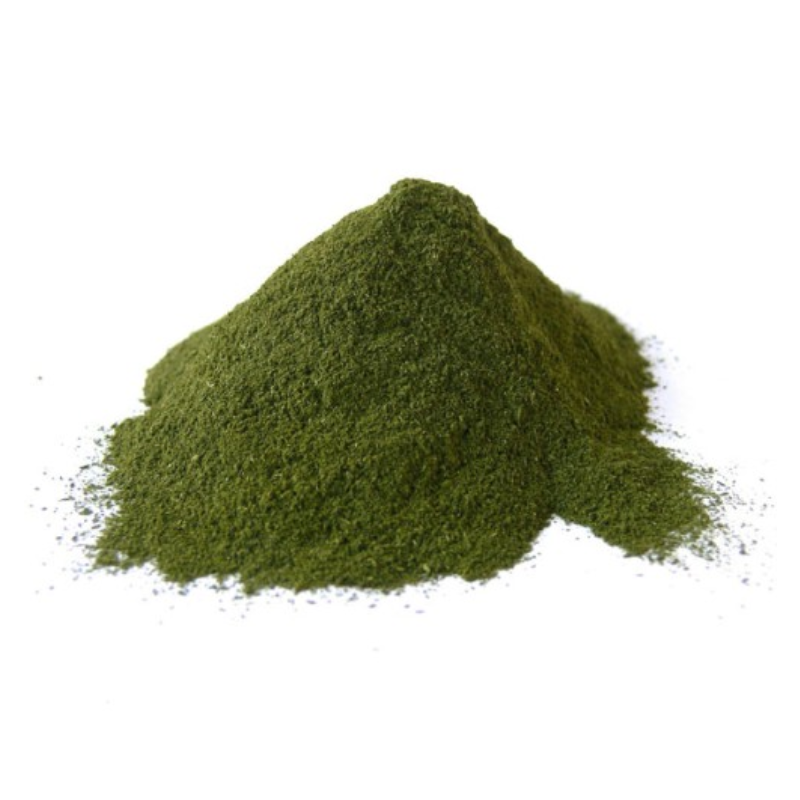Wheat grass Powder - Herbal Collection
Wheat grass Powder - Herbal Collection - 100 GR is backordered and will ship as soon as it is back in stock.
Description
Description
Triticum aestivum
Wheatgrass Powder - 100 g - Herbal Collection
TRADITIONALLY USED FOR
Wheatgrass powder has a wide range of traditional uses, and there are several ways to incorporate it into your diet. Here's a breakdown:
Traditional Uses of Wheatgrass Powder
- Detoxification: Wheatgrass is believed to help cleanse the body of toxins and impurities.
- Boosting Immunity: The high vitamin and antioxidant content may support the immune system.
- Improving Digestion: The fiber in wheatgrass can aid digestion and promote regularity.
- Blood Health: Wheatgrass is thought to boost hemoglobin levels and support overall blood health.
- Alkalizing the Body: Some believe wheatgrass can help restore a healthy pH balance.
- Skin Health: Can be used topically or consumed for potential benefits like reducing inflammation and promoting clear skin.
How to Prepare and Use Wheatgrass Powder
- Wheatgrass Shots: The most common way is to mix 1-2 teaspoons of wheatgrass powder with a small amount of water or juice and drink it quickly as a "shot."
- Smoothies: Add wheatgrass powder to your favorite smoothies for a nutritional boost. It blends well with fruits, vegetables, and other healthy ingredients.
- Juices: Mix wheatgrass powder into fresh juices for added nutrients.
- Capsules: If you dislike the taste, wheatgrass powder is available in capsule form.
- Topical Application: You can create a paste with wheatgrass powder and water for potential skincare benefits.
Tips:
- Start Slow: Begin with a small amount (1/2 teaspoon) and gradually increase to avoid any digestive upset.
- Taste: Wheatgrass has a grassy, earthy flavor, which some find unappealing. Blending it with fruits or juices can improve the taste.
- Quality Matters: Choose organic, high-quality wheatgrass powder for the best results.
Important Considerations:
- Talk to Your Doctor: Consult your healthcare provider before using wheatgrass, especially if you have health conditions or are on medications.
- Not a Cure-All: While wheatgrass has potential benefits, it shouldn't be treated as a cure for any disease or replace professional medical advice.
INFORMATION
Source : http://www.wikiphyto.org/wiki/Wheatgrass
Reference on http://www.wikiphyto.org
Translation in English by Google Translate (go to the page of the source linked | on Chrome cellphones go on the 3 dots on the top right and select translate in your preferred language | on laptop right click your mouse and select option translate when hoovering on the page
plant name
cultivated wheat, cultivated wheat , wheat
International Latin denomination
Triticum sativum Lam. = Triticum aestivum L., Triticum sp .
botanical family
Poaceae
Description and habitat
- Monocotyledonous herbaceous plant, it is the most produced and consumed cereal in the world, there are more than 20,000 varieties
- Its consumption dates back to the 8th millennium BC. AD, in the Fertile Crescent region (Tigris and Euphrates valleys)
- Two species dominate production: soft wheat and durum wheat
History and tradition
- Cultivated wheat (Wheat, Wheat ) Triticum sativum food
- Einkorn or spelled Triticum monococcum
- Wild einkorn is Triticum monococcum L. subsp . aegilopoides (Link) Thell.
Parts used
Dosage forms available
Usual dosages
Composition
Main components of the plant
- Amidon, gluten , gliadins
- Composition of wheat germ oil:
- Alpha linolenic acid 7%, linoleic acid 53%, oleic acid 0%
- High content of vitamin E and unsaponifiable
Main components of buds or young shoots
Main components of essential oil
Properties
Plant properties
- Wheat germ oil: cholesterol-lowering, LDL-cholesterol reduction, antioxidant
- The gluten of modern varieties would be responsible for a syndrome called "non-celiac gluten sensitivity" [1] , [2]
- The CXL10 molecule, overexpressed in the intestinal mucous membranes of patients suffering from celiac disease and autoimmune diseases, would contribute to the loss of the intestinal barrier function, the old varieties would be less responsible for this phenomenon [3]
- The gliadin of small spelled would be less toxic for the intestine than that of wheat [4]
- Sprouted wheat has antitumor and anticancer properties [5] , [6] , [7]
Bud properties
Properties of essential oil
Indications
Indications of the whole plant (phytotherapy)
Indications of the bud (gemmotherapy)
Specific indications of essential oil (aromatherapy)
Known or suspected mode of action
Usual formulations
Regulations
- French Pharmacopoeia list A (sound)
Possible side effects and precautions for use
Bibliographic references
- Go↑ Mansueto P, Seidita A, D'Alcamo A, Carroccio A. Non-celiac gluten sensitivity: literature review. J Am Coll Nutr. 2014;33(1):39-54. doi: 10.1080/07315724.2014.869996. PMID 24533607
- Go↑ Catassi C, Bai JC, Bonaz B, Bouma G, Calabrò A, Carroccio A, Castillejo G, Ciacci C, Cristofori F, Dolinsek J, Francavilla R, Elli L, Green P, Holtmeier W, Koehler P, Koletzko S, Meinhold C, Sanders D, Schumann M, Schuppan D, Ullrich R, Vécsei A, Volta U, Zevallos V, Sapone A, Fasano A. Non-Celiac Gluten sensitivity: the new frontier of gluten related disorders. Nutrients. 2013 Sep 26; 5 (10): 3839-53. doi: 10.3390 / nu5103839. PMID 24077239
- Go↑ Valerii MC, Ricci C, Spisni E, Di Silvestro R, De Fazio L, Cavazza E, Lanzini A, Campieri M, Dalpiaz A, Pavan B, Volta U, Dinelli G. Responses of peripheral blood mononucleated cells from non-celiac gluten sensitive patients to various cereal sources. Food Chem. 2015 Jun 1;176:167-74. doi: 10.1016/j.foodchem.2014.12.061. PMID 25624220
- Go↑ Pizzuti D, Buda A, D'Odorico A, D'Incà R, Chiarelli S, Curioni A, Martines D. Lack of intestinal mucosal toxicity of Triticum monococcum in celiac disease patients. Scand J Gastroenterol. 2006 Nov;41(11):1305-11. PMID 17060124
- Go↑ Mueller T, Voigt W. Fermented wheat germ extract--nutritional supplement or anticancer drug? Nutr J. 2011 Sep 5;10:89. doi: 10.1186/1475-2891-10-89. PMID 21892933
- Go↑ Mueller T, Jordan K, Voigt W. Promising cytotoxic activity profile of fermented wheat germ extract (Avemar®) in human cancer cell lines. J Exp Clin Cancer Res. 2011 Apr 16;30:42. doi: 10.1186/1756-9966-30-42. PMID 21496306
- Go↑ Otto C, Hahlbrock T, Eich K, Karaaslan F, Jürgens C, Germer CT, Wiegering A, Kämmerer U. Antiproliferative and antimetabolic effects behind the anticancer property of fermented wheat germ extract. BMC Complement Altern Med. 2016 Jun 1;16:160. doi: 10.1186/s12906-016-1138-5. PMID 27245162
CAUTION
Store in a cool, dry place, away from light. Keep tightly closed, away from the reach of Children and pets.
Do not exceed the daily dose.
This product is not intended to prevent or cure any form of illness or disease.
If you are pregnant or nursing ; If you have a medical condition or are in the course of medical treatment ; If you are programmed for theater/operation in the near future, please consult your healthcare practitioner before using this product.
This product cannot replace a varied and balanced diet and a healthy lifestyle.
This product has not been evaluated by the SAHPRA for its quality, safety or intended use.
For More Information please check our General Safety Herbal products Page






